Andrez Bergen's Blog, page 9
July 28, 2011
Japan Sinks author Komatsu passes on
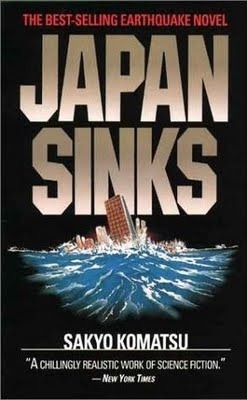
Just found out that the great Sakyo Komatsu, author of the novel Japan Sinks (日本沈没 Nihon Chinbotsu) passed away on 26 July, at the venerable age of 80.
"Japan Sinks" might fittingly apply to this country itself in 2011 with the slew of disasters since March. Five years ago it was adapted as a fairly mediocre SFX/romance yarn starring Tsuyoshi Kusanagi (from J-pop group SMAP) and Kou Shibasaki (Battle Royale, 47 Ronin) in which - racked by earthquakes, firestorms and volcanoes - Japan is slowly sinking into the sea.
Much better was the 1973 version (also called Tidal Wave) directed by Shiro Moritani, starring Keiju Kobayashi (Samurai Assassin) and Kunihiro Fujioka (the first Kamen Rider), along with a soundtrack by Masaru Satō - who scored the Akira Kurosawa films Throne of Blood, The Bad Sleep Well, Yojimbo and Sanjuro.
Komatsu even makes a cameo at the beginning of the movie.
Less renowned in the West is the entity alternately known as Sayonara Jupiter (さよならジュピター) or Bye Bye Jupiter - a novel he adapted himself for the somewhat ill-conceived trilingual 1984 Toho movie directed by Koji Hashimoto (Godzilla 1985: The Legend Is Reborn).
That outing is just plain bizarre, yet worth another ride into the imagination conjured up by one of Japan's more creative writers. As a tribute, here's something a wee bit oddball: the Russian-dubbed trailer for the 1973 version of Japan Sinks.
Published on July 28, 2011 02:27
July 24, 2011
Heavenly Spirits?

In the 1967 James Bond film You Only Live Twice, there's an essential exchange between our globetrotting British spy (Sean Connery) and his Japanese counterpart Tiger Tanaka (played by Tetsuro Tanba but voiced by Robert Rietti).
This moment comes just after Bond is offered the rice-based alcoholic beverage sake, instead of his usual dry vodka martini. He surprises all when he graciously accepts, saying that he enjoys the Japanese drop – especially when it's served at the 'correct temperature', 98.4 degrees Fahrenheit.
The moment is something to drink in, and 98.4ºF would sound fair enough to most people since, in common Western perception, sake is doled up piping hot to wash down raw fish. But for those a tad more in the know about Japanese cuisine a rumour has circulated over the past 44 years that Bond got it wrong; that sake served at this temperature – 37ºC for those like me who are Fahrenheit inept – is invariably inferior in quality.
In truth that might have indeed been the case in the mid '60s, around the time of the making of You Only Live Twice, as many breweries fortified their product with distilled alcohol – a hangover from Second World War rice shortages. Serving it steaming helped mask any of the sharp or unbalanced flavours.
But in the intervening period brewers have been able to return to the prescribed method of naturally brewing pure rice sake, with no shoehorned artificial alcohol, to recreate mixes that are refined and pure enough to serve chilled.
Even so, we don't need to take sides here.

Bond wasn't wrong – and neither were the rumours. 98.4ºF isn't exactly the 'correct' temperature for sake, but it's perfect for Ozeki One Cup and some more expensive premium blends; the Japan Sake Brewers Association reports that this drink can be enjoyed anywhere within the range of 5ºC (41ºF) to 55ºC (131ºF), depending on the concoction.
Then there's the Holy Grail of modern day nihonshu (which is what the Japanese tend to call sake).
Myouka Rangyoku ('heavenly flower') has been touted as the world's best sake at urbansake.com and in the pages of The Japan Times newspaper – and like all chart-topping, divinely-inspired beverages this one comes with a healthy price tag: A 720 ml bottle retails upwards from ¥12,600 (about US$150).
"As a brewery, we do our utmost to create a truly great and perfect sake with Myouka Rangyoku – made according to a totally new concept, both as regards the flavour of the sake and the design of the bottle – and therefore we have been able to have a sizeable impact."
So last year I was informed by Ad G. Blankestijn, the Director of Overseas Marketing and Sales at Daishichi Sake Brewing Co., Ltd., located in Fukushima, 230 km northeast of Tokyo.
Unfortunately this placed the brewery slap-bang in the middle of the massive March 11 earthquake and subsequent tsunami, and they're located 60 km from the ongoing nuclear reactor debacle at Fukushima Daiichi.

On their website they strive to be reassuring:
"The walls of the brewery consist of 25 cm thick concrete. In addition there are fire-resistant tiles and hollow concrete blocks, making a total of 32 cm of protection from the outside. The sake storage area has even thicker walls in order to keep the products cool. No radiation can penetrate these walls.
"When we heard about the nuclear problems on March 11, we have immediately stopped air conditioners and ventilators and covered the windows and air ducts in plastic sheets to keep the inside of the brewery and storage areas airtight.
"Sake brewing is almost finished and the accident has had no major influence on our activities. Products being shipped now are vintage 2008-2009 sakes, and 2010 for the plum sake. These products are completely free from any influence of the nuclear accident."
I haven't spoken to Blankestijn at the brewery since I interviewed him last year, but the nuclear crisis is in no way going to deter me from my aspiration to (one day) road-test this particular drop.
Even bottles matter to these people and theirs is a classic (see below); the brew itself has been dubbed ambrosial by critics far more canny than myself.
"Most exclusive sakes are made with a modern, simplified process, but ours has been made with the 'Kimoto' method, the most traditional, laborious and time-consuming way of brewing a handcrafted sake," Blankestijn said.
"The result is that it tastes very pure while at the same time possessing much complexity and depth. In contrast to other exclusive sakes which have to be drunk relatively young, Myouka Rangyoku is very slowly matured, so that over the course of many years it ripens into a rich and beautiful sake that we do not sell every year; we only make it in good years when we can attain the highest level. And even then, we only make it in a limited quantity. Of course, we are happy with the very positive judgment of many sake specialists, as well as the fact that it is often selected by the Japanese government for important diplomatic events – such as at the G8 Summit in 2008 in Hokkaido."
While it's kind of tricky to hope that the nuclear crisis gets nipped in the bud overnight when people like Prime Minister Naoto Kan mutter that it'll take somewhere in the vicinity of two decades to clean up, I have several fingers crossed that essential Japanese sake brewers like Daishichi can get back into the groove of their handicraft as soon as possible.
Only final final word needs to be uttered here. Kampai! 乾杯

Published on July 24, 2011 14:27
July 16, 2011
Hot under the (shirt) collar
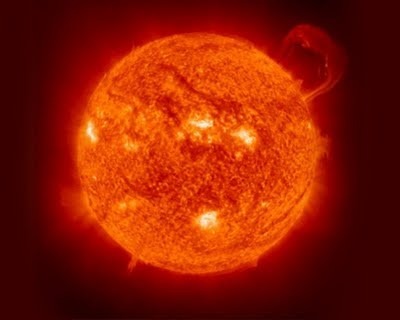
It's been baking in Tokyo over the past couple of weeks or so.
As I teach my students new adjectives to replace the just plain inadequate 'hot' (think roasting, cooking, etc), I'm enjoying the weather.
When I first came to Tokyo 10 summers ago, it was overcast, humid as heck and sticky. The kind of heat we're getting now, while it occasionally tumbles back into that Tokyo cliché, is more like that I remember from Australia: a blue sky, sizzling sun and high temperatures.
I other words I love it - except when I have to go to work, wearing a darn tootin' suit. Ack.
The problem may be that other people, not quite so fond of the scorched-earth temperatures and affected by the power shortages caused by the loss of power from the Fukushima Dai-Ichi nuclear plant (and others since shut down), will find it hard going and health concerns like heat stroke are already in play.
The Japanese government has appealed for people to save on electricity by raising the temperature settings on air conditioners to a minimum of 28°C.
Most people are also hesitant about heading off to the local beaches since there's that nuclear hazard still pumping away up north-east, and related "hot-spots" (of the radioactive rather than sun-related kind) popping up around the city.
Last summer went on record as Japan's hottest ever; now we have summer 2011 to look forward to. P'raps luckily I'll be whizzing down to Melbourne in August for a couple of weeks, to torture myself with a temperature about 30 degrees lower.
Then again, give me the sun, a t-shirt (sans witless collar) and shorts, plus a chilled beer in a park, and I'll be fine. Maybe an el cheapo wading pool to dip my feet in would just add to the attraction?
Published on July 16, 2011 19:23
July 10, 2011
Captain Funk: Versions 2011
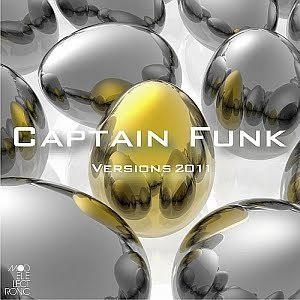
Before I came to Japan in 2001, I was already a bit obsessive/compulsive about Japanese electronic music - I loved Yellow Magic Orchestra's back-catalogue as well as that of Mo' Wax contributors Major Force West Productions and DJ Krush, not to mention techno-meisters like Fumiya Tanaka, Takkyu Ishino, Co-Fusion, DJ Shufflemaster and Captain Funk.
As it shaped up I've since become mates with some of these people, in particular DJ Wada from Co-Fusion and Captain Funk's Tatsuya Oe. Both guys graciously did remixes of a couple of my tracks - Wada renovated 'Compulsion', while Oe had a shot at 'Cocaine Speaking', both of which appear on a recent CD ('Commix') through Japanese label Fountain Music - and I'm a huge fan of both gents as much for their wunderbar temperament as their talents behind rack-mounted machines and music-making software.
Anyone who's bothered to peruse this wayward blog (and with a long memory to boot) may recall my piece on Star Trek's impact in Japan - or at least lack of same - back in 2009. Tatsuya was one of the contributors there, and in fact I often call on him for his two or three cents on different silly articles I do as he's always into it and forever patient.
Anyway, he just emailed me to let me know that he's doing likewise fine here in Tokyo despite the recent spate of shakes, and is is about to unleash his Captain Funk "Versions 2011″LP worldwide tomorrow (July 11th in case you don't have a calendar handy).
Tatsuya's style has come a long way since those '90s inroads I mentioned above, and he's become one of this city's most in-demand DJ/producers, so it's definitely worthwhile checking this baby out. You can find out more by heading to his website.
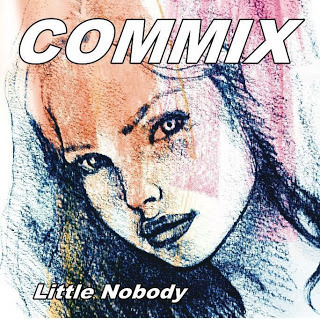
Meanwhile, for those far more adept at foreign languages than I am, here's the Japanese propaganda bomb:
Captain Funk の新作"Versions 2011″ が7月11日にリリースされることになりました。
収録内容はロック色の強い新曲"Endless Possibilities"に加えて、これまでのCaptain Funkのリリース楽曲を2011年版として大幅にアレンジ改訂した"I'll be There"と"Just Wanna Get You Tonight"の2曲、そしてこの数年Ne-YoやPhonat, Kavinsky などのリミックスで注目が集まっているフランスのプロデューサーBestrack Production (http://www.myspace.com/bestrackprod) による"Piece of You"(原曲は米国Forver 21のプロモーションで使用)のリミックスの4曲になっています。
このリミックスも含めて、それぞれ新しいオリジナル楽曲と同等の「2011年最新バージョン集」としてお楽しみ頂けるのではないかと思います。
どの曲もいつも通りファットでブライトなサウンドに仕上がっていると思いますが、特に"Just Wanna Get You Tonight" 2011年バージョンは "Weekend (kissing, touching, tasting, loving)"の流れを汲む、夏らしくダンサブルなアレンジになっていますので、これからの季節に向けて是非チェックしてみて下さい。
(Reverbnation のCaptain Funk ページにて各楽曲の試聴サンプルをアップしました。そちらもご参照下さい。)
尚、今回のリリースは米国のディストリビューションを通じて、日本を含めた各国のiTunes, Amazon, Beatport その他のMP3ストア、Spotify, We7などのストリーミングサービスで世界同時配信されます。
Published on July 10, 2011 01:43
July 7, 2011
Crow Castle in a Flap
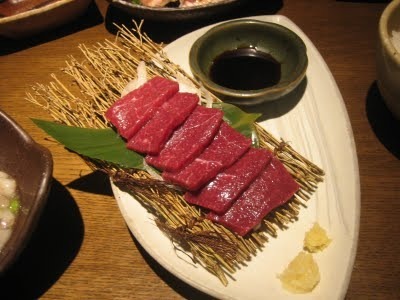
Just a three-hour drive east of Shinjuku on the Keio Line Bus is Matsumoto, in the mountainous Nagano Prefecture.
This is the sister-city to Utah's Salt Lake City and Nepal's Kathmandu, and is one of the best places to try basashi (raw horse meat) and soba (buckwheat noodles).
The city itself is located on an open plain in the Japanese Alps, just over half an hour from the historic watermills at the nation's largest wasabi farm – Daio at Azumino – where Akira Kurosawa in fact shot part of his epic movie about his own fitful Dreams (1990).
But the standout here is Matsumoto Castle (松本城), and it's actually a genuine keep unlike the faux fort closer to Tokyo at Odawara.
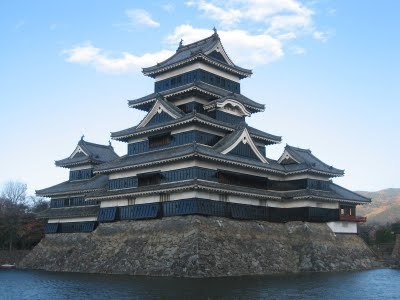
Matsumoto Castle is a gorgeous and immaculately maintained building that dates back to the Sengoku (Warring States) era prior to the 17th century. It's locally dubbed 'Karasu-Jo' (Crow Castle) because of the somewhat sinister black lines, but for me (I've visited twice) this is a stunning place that lives up to its confirmation as a National Treasure of Japan in 1952.
It's one of only four castles in this country to receive the honour.
But 2011 hasn't been kind to Japan.
Unless you've had your head buried deep inside one very big sandpit, you'd know all about the huge earthquake and follow-up tsunami on March 11, followed by worrying ripples in the economy and a continuing radioactive crisis at the Fukushima Daiichi nuclear power plant 230km northeast of Tokyo.
We've had thousands of aftershocks and earthquakes across the country over the following four months, and one of these earthquakes – with a magnitude of 5.4 – rocked Nagano on Thursday June 30.
Aside from minor injuries to local residents – although I'm not sure if the people themselves would call broken bones trivial – the quake caused around ten large cracks in the inner walls of the main tower of Matsumoto Castle.
After 400 years successfully circumnavigating civil wars, neglect, deconstruction, renovation and tourism, let's hope Karasu-Jo's earthquake damage isn't so serious and – like the rest of Japan – it makes a complete recovery.
(This is part of an article that appears on the Forces Of Geek site - you can read more of that yarn here.)
Published on July 07, 2011 13:05
July 2, 2011
The Goat in the Sky
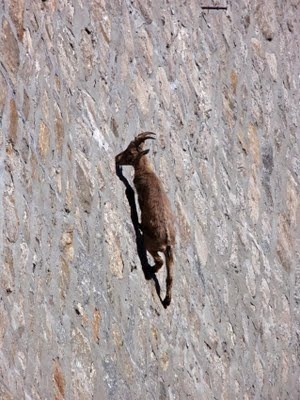
There's now an in-depth interview of my editor Kristopher Young and me - by the cool Martin Garrity - online @ Solarcide, regarding Tobacco-Stained Mountain Goat.
Martin writes:
"TSMG is an odd sci-fi tale of corruption in a dystopian future, set in Melbourne, Australia. (Bergen is himself Australian, though he now lives in Japan) It features an immediately likeabe protagonist, Floyd Maquina, who is a government endorsed 'seeker.' Floyd's job is to hunt the deviant menace that threatens the future of the last inhabited city on the planet. This could almost be a special edition, Vegemite-flavoured version of a certain Philip K. Dick story.
"But that ain't even the half of it.
"TSMG is also homage to the golden age of film noir. It's a cigar puffing, whiskey sipping, piano playing, bar lout, and the book may very well stir up memories of a black and white nature. Andrez makes a million and one references to movies (The Third Man and The Maltese Falcon, in particular, are heavily drawn on) and the settings are stuffed to the margins with inspiration from this classic era of cinema."
I actually really dug doing this interview; Martin was great to yack with and he asked some canny questions - and I really loved the head-to-head between he and Kristopher.
Anyway, you can read it if at all interested HERE.
Cheers, Martin! ;)
Published on July 02, 2011 19:31
June 25, 2011
Monitoring the Microsieverts
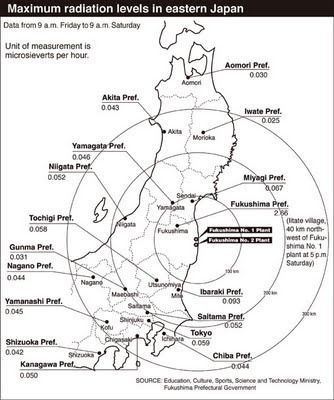
I'll be the first to admit it - I'd never even heard of microsieverts, and I grew up during the Cold War, until a couple of months ago when the Fukushima Daiichi nuclear plant blew its lid post March 11 earthquake and tsunami.
Given that I live in Tokyo, we're said to be far safer than residents in Fukushima itself, since we're 230km from the ongoing fiasco. Mostly I like to believe that, but it's tricky when you harbour some suspicions about TEPCO, the owners of the plant, and just how much information the Japanese government is giving out.
Things like bunnies born without ears, irradiated tea, and YouTube clips of Geiger counter readings in playgrounds in nearby Kashiwa, here in Tokyo, do cause you to fret just a wee bit. The only thing to do is to keep a baker's dozen of eyes on all sources of info - official and hysterical - and draw a line somewhere down the middle.
That and a lucky rabbit's foot will hopefully see things through. Right?
Published on June 25, 2011 20:00
June 23, 2011
Battle Royale (2000)
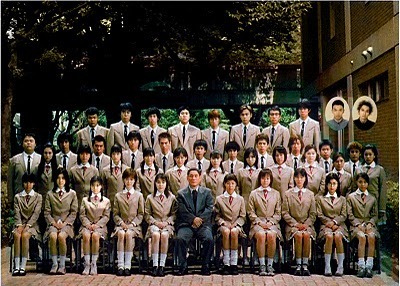
This violent, often wildly hilarious - and disturbing - gem is p'raps not quite so obscure now, eleven years on, as when it was first released in Japan.
And the truth is that Battle Royale (バトル・ロワイアル) would've made a far more fitting obituary for director
You certainly couldn't take style, content and inspiration any further a field from Fukasaku senior's earlier action-adventure romp Legend Of 8 Samurai, nattered about in this blog a while back.
So clear your frazzled silly-season brain. It's a not-too-distant future. Japan is again a fascist state. An arbitrarily-chosen bus full of high school kids are knocked out with sleeping gas, kidnapped, then shipped on to an isolated island - where they're informed by their embittered former teacher Kitano ('Beat' Takeshi Kitano) that the only way they will leave said island is by killing all their classmates – or by ending up in a body-bag themselves.
In order to enforce this mandate, each student is shackled with an exploding collar, à la Wedlock, and Kitano punctuates the students' plight with a well-aimed penknife to one of the girl's foreheads, thereby launching a battle for self-preservation.
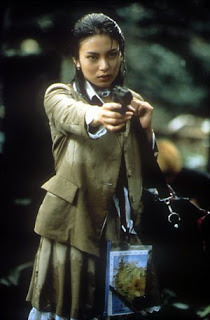
Shuja (
There're some hilarious acting histrionics and amateur execution techniques along the way, and the true stand-outs are Takako (played by
While he previously popped up in a not-so-memorable English language role in the Keanu Reeves vehicle Johnny Mnemonic (1995), Kitano was outstanding in his own movies Sonatine (1993), Hana-bi (1997), and Zatoichi (2003). Here the actor underpins the rancorous teacher - with a 'pen' chance for revenge - with a whimsical ease and blasé humour that's gloriously disturbing.
Some incongruous orchestral music by Johann Sebastian Bach is thrown in for good measure, as well as an overall soundtrack by Masamichi Amano – who previously scored the ultra-violent anime Legend Of The Overfiend (1989).
Last summer I went in search of the Tsurugizaki Lighthouse that was used in Battle Royale.
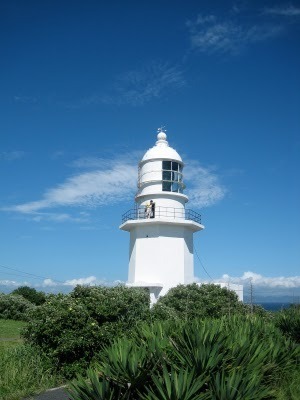
I took a swag of happy snaps of said light tower, got sunburned, walked for several hours, and discovered some obscure fishing villages as well as a cliff-side walkway that was more dangerous than fun.
It was also crawling with those beach cockroaches I mentioned in earlier entries (Shikinejime, for instance).
But honestly? I had one of the best times of my life.
Published on June 23, 2011 14:31
June 19, 2011
Mutant Cherries (Japan)
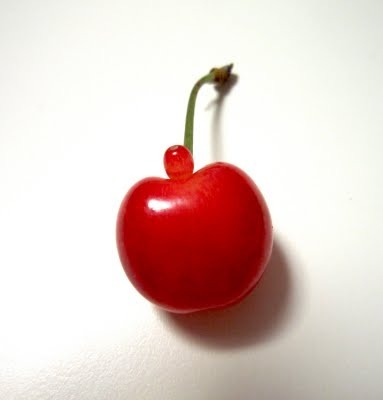
When I was a kid I grew up on Marvel Comics from the '60s (sourced from my older step brother's horde) and the '70s, and via The X-Men - as well as the 1970 movie Beneath the Planet of the Apes, starring James Franciscus and Charlton Heston - I learned early that radiation causes mutation.
In the case of The X-Men the process granted them some pretty nifty powers; in Beneath the Planet of the Apes the mutants might've been able to read minds, but it seemed to me at the time that they were also bludgeoned with the ugly stick several times over.
Being a Cold War kid meant you seriously expected the end of the world to come from nuclear warfare (since there were something like seven missiles aimed at every major city in the world) and/or the radioactive aftermath.
Mother Nature was another matter entirely.
I grew up being wary of bushfire risks in Australia, and we once caught a Greyhound bus south from the Gold Coast with flames on either side of the highway, but I'm too young to remember it and my mum paints her own memory vivid.

And yet while the earthquake and tsunami here were scary tastes of nature at its most volatile, nothing really prepares you for big business gone incompetent.
These are two cherries we got in a batch as a gift yesterday from a friend.
They're sourced from the prefecture next to Fukushima, where the nuclear plant is still spewing radioactive stuff while the inept owners (TEPCO) blunder on and refuse to give clear details about very much at all - including accurate reading updates regarding the levels of caesium-137 et al that are slipping out and across the country.
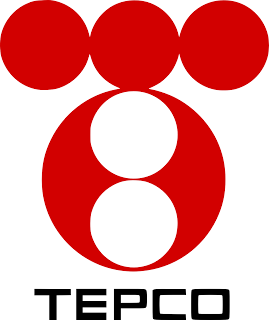
The cherries are seriously deformed; it's like those three cherries on top of the TEPCO logo were sent back to DNA design school but dropped out too early.
I went cherry picking when I was 18 back in Australia and in a week of plucking the buggers I never came across anything like these. The Siamese ones are particularly striking, but my daughter says the other one, with a poking out appendage, has an eye.
Speaking of eyes, it all reminds me of the three-eyed fish from The Simpsons.
Worrisome? Hmmm. I'll get back to you on that.
Published on June 19, 2011 13:13
June 17, 2011
Perc Trax vs. Blank Records
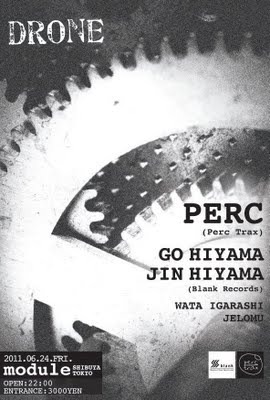
Wunderbar news, this.
Two of my favourite Japanese DJ cum producers are getting together with a certain UK industrial/techno enfant terrible named Ali Wells - better known as Perc - here in Tokyo at Module on 24 June.
Ali runs the appropriately-named Perc Trax, which has been one of my preferred labels over the past few years, and I recently interviewed him for the Techno How? site.
The two Japanese guys are Jin Hiyama and his brother Go. Jin is a good mate of mine (he played at my book launch in March), and I interviewed Go a couple of months ago here.
This should be an absolutely brilliant gig; shame is that it shapes up I may not be in town to actually appreciate it...
Address: 150-0042東京都渋谷区宇田川町34-6M&IビルB1F/B2F
Cost: ¥3,000 on the door.
Published on June 17, 2011 16:35



